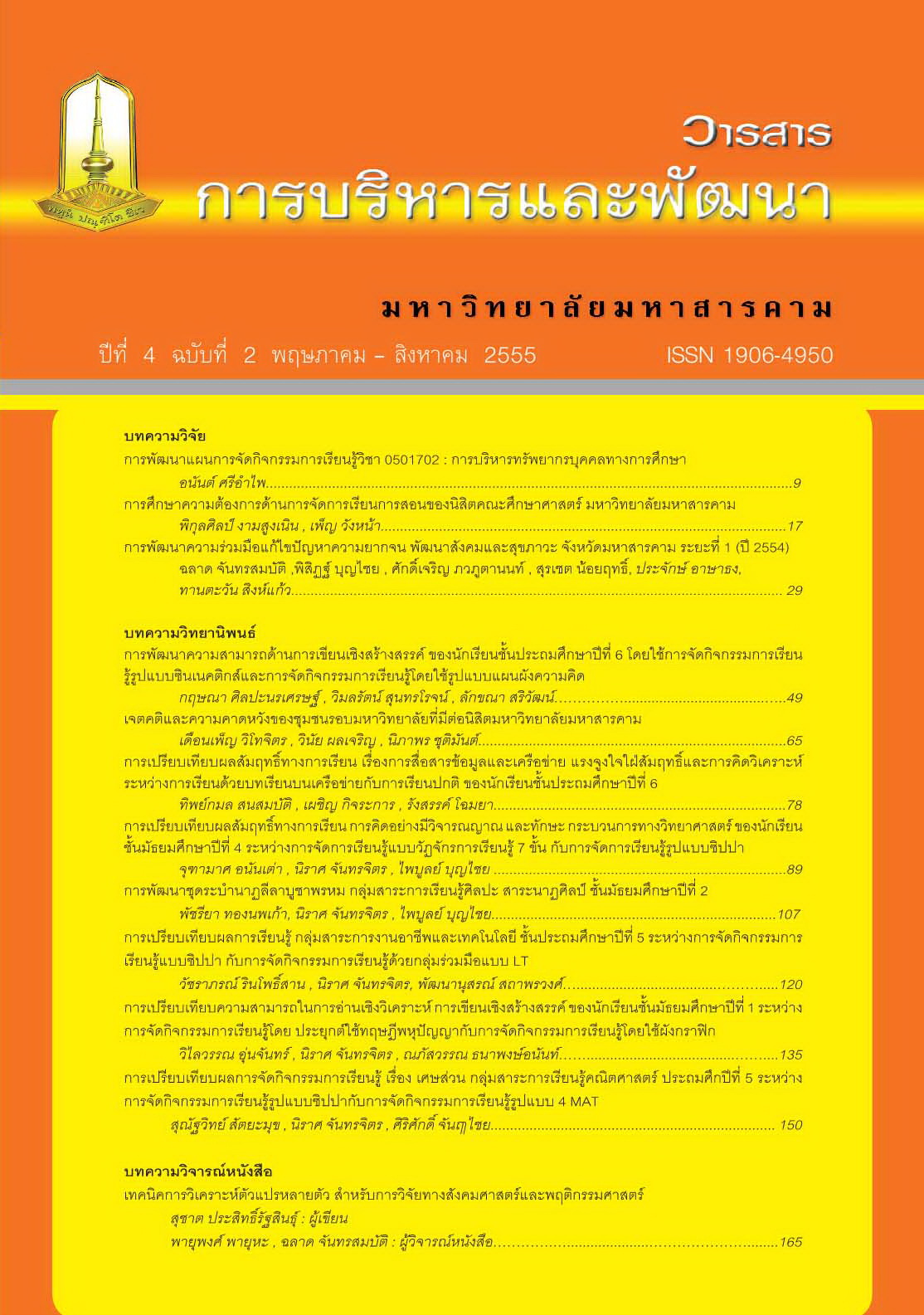การพัฒนาชุดระบำนาฏลีลาบูชาพรหม กลุ่มสาระการเรียนรู้ศิลปะสาระนาฏศิลป์ ชั้นมัธยมศึกษาปีที่ 2
Main Article Content
Abstract
บทคัดย่อ
การวิจัยครั้งนี้มีความมุ่งหมายเพื่อ (1) หาประสิทธิภาพของชุดระบำนาฏลีลาบูชาพรหม ชั้นมัธยมศึกษาปีที่ 2 ตามเกณฑ์75/75 (2) หาดัชนีประสิทธิผลของชุดระบำนาฏลีลาบูชาพรหม (3) ศึกษาประสิทธิภาพของแผนการจัดกิจกรรมการเรียนรู้แบบกลุ่มร่วมมือโดยใช้ชุดระบำนาฏลีลาบูชาพรหม ชั้นมัธยมศึกษาปีที่ 2 ตามเกณฑ์80/80 (4) หาดัชนีประสิทธิผลของแผนการจัดกิจกรรม การเรียนรู้แบบกลุ่มร่วมมือโดยใช้ชุดระบำนาฏลีลาบูชาพรหม และ (5) เปรียบเทียบคุณลักษณะ การยอมรับนับถือตนเองของนักเรียนชั้นมัธยมศึกษาปีที่2 ที่จัดกิจกรรมการเรียนรู้โดยใช้ชุดระบำนาฏลีลาบูชาพรหม ระหว่างก่อนเรียนและหลังเรียน กลุ่มตัวอย่างในการวิจัยครั้งนี้ได้แก่นักเรียนชั้นมัธยมศึกษาปีที่ 2 โรงเรียนจตุรพักตรพิมานรัชดาภิเษก อำเภอจตุรพักตรพิมาน จังหวัดร้อยเอ็ด ในภาคเรียนที่ 2 ปีการศึกษา2552 จำนวน 43 คนซึ่งได้มาโดยการสุ่มแบบกลุ่ม (Cluster Random Sampling) เครื่องมือที่ใช้ในการวิจัย ได้แก่ (1) ชุดระบำนาฏลีลาบูชาพรหม ประกอบการจัดกิจกรรมการเรียนรู้แบบกลุ่มร่วมมือ กลุ่มสาระการเรียนรู้ศิลปะสาระนาฏศิลป์ จำนวน 10 ชุด ผลการประเมินคุณภาพเท่ากับ 4.42 (2) แผนการจัดกิจกรรมการเรียนรู้แบบกลุ่มร่วมมือ เรื่องระบำนาฏลีลาบูชาพรหม จำนวน 10 แผน มีผลการประเมินคุณภาพเท่ากับ 4.52 (3) แบบทดสอบวัดผลสัมฤทธิ์ทางการเรียน เรื่อง ระบำนาฏลีลาบูชาพรหม ชั้นมัธยมศึกษาปีที่ 2 แบบปรนัยเลือกตอบจำนวน 30 ข้อ มี ค่าอำนาจจำแนกรายข้อ (B) ตั้งแต่ 0.23 ถึง 0.85 มีค่าความเชื่อมั่นทั้งฉบับ (rcc ) เท่ากับ 0.86 (4) แบบวัดภาคปฏิบ้ติของนักเรียน เป็นแบบวัดทักษะภาคปฏิบัติด้านการรำ ครอบคลุมความสามารถ และทักษะการรำ 6 ด้านจำนวน 1 ฉบับ มีค่าความยาก (P) ตั้งแต่ 0.26-0.67 มีค่าอำนาจจำแนกรายด้าน (D) ตั้งแต่ 0.54 -0.87 และมีค่าความเชื่อมั่นทั้งฉบับ (α) เท่ากับ 0.87 และ (5) แบบวัด การยอมรับนับถือตนเอง เป็นแบบวัดชนิดมาตราส่วนประมาณค่า (Rating Scale) 5 อันดับจำนวน 15 ข้อ มีค่าอำนาจจำแนกรายข้อ (rxy ) ตั้งแต่ 0.31 -0.83 และ มีค่าความเชื่อมั่นทั้งฉบับ (α) เท่ากับ0.90สถิติที่ใชในการวิเคราะห์ข้อมูลได้แก่ค่าเฉลี่ยร้อยละ ส่วนเบี่ยงเบนมาตรฐาน และการทดสอบสมมติฐานการวิจัยด้วย t-test (Independent Samples)
ผลการวิจัยปรากฏดังนี้
1. ชุดระบำนาฏลีลาบูชาพรหม สาระนาฏศิลป์ ชั้นมัธยมศึกษาปีที่2 มีประสิทธิภาพเท่ากับ 78.47/76.61 ซึ่งเป็นไปตามเกณฑ์ที่ตั้งไว้
2. ดัชนีประสิทธิผลของชุดระบำนาฏลีลาบูชาพรหม ชั้นมัธยมศึกษาปีที่ 2 มีค่าเท่ากับ 0.5141 แสดงว่านักเรียนมีความก้าวหน้าทางการเรียนคิดเป็นร้อยละ 51.41
3. แผนการจัดกิจกรรมการเรียนรู้แบบกลุ่มร่วมมือโดยใช้ชุดระบำนาฏลีลาบูชาพรหม ชั้นมัธยมศึกษาปีที่ 2 มีประสิทธิภาพเท่ากับ 83.84/80.58 ซึ่งสอดคล้องกับเกณฑ์ที่ตั้งไว้
4. แผนการจัดกิจกรรมการเรียนรู้แบบกลุ่มร่วมมือโดยใช้ชุดระบำนาฏลีลาบูชาพรหม ชั้นมัธยมศึกษาปีที่ 2 มีค่าดัชนีประสิทธิผลเท่ากับ 0.6049 แสดงว่านักเรียนมีความก้าวหน้าทางการเรียนคิดเป็นร้อยละ 60.49
5. นักเรียนชั้นมัธยมศึกษาปีที่ 2 มีคุณลักษณะการยอมรับนับถือตนเองหลังเรียนด้วยชุดระบำนาฏลีลาบูชาพรหม เพิ่มขึ้นจากก่อนเรียนอย่างมีนัยสำคัญทางสถิติที่ระดับ .01
คำสำคัญ : การพัฒนาชุดระบำนาฏลีลาบูชาพรหม, กิจกรรมการเรียนรู้แบบกลุ่มร่วมมือ, ผลสัมฤทธิ์ทางการเรียน, คุณลักษณะการยอมรับนับถือตนเอง, ทักษะการรำ
ABSTRACT
The purposes of this study were : 1) to find out the efficiency of Boochar-Phrom Dancing Set in classical dance strand for Matthayomsuksa 2 level, with a required efficiency of 75/75, 2) to find out effectiveness indices of the Boochar-Phrom Dancing Set in classical dance strand, 3) to find out the effectiveness of lesson plan of Boochar- Phrom Dancing Set with cooperative learning in classical dance strand, with a required efficiency of 80/80,4) to find out effectiveness indices of lesson plan of the Boochar-Phrom Dancing Set with cooperative learning in classical dance strand, and 5) to compare self-esteem of Mathayomsueksa 2 students, between before and after learned by using lesson plan of the Boochar-Phrom Dancing Set in classical dance strand. The research samples consisted of 43 Mathayomsueksa 2 students attending Jaturapakphiman school, Jaturapakphiman District, Roi-Ed Province in the second semester of the academic year 2009, obtained using the cluster random sampling technique. The instruments used in this study were : (1) 10-set of Boochar-Phrom Dancing with cooperative learning in classical dance strand, those had quality evaluated score of 4.42 ; (2) 10- plans for organization of learning activities of the Boochar-Phrom Dancing Setwith cooperative learning in classical dance strand, those had quality evaluated score of 4.52 ; (3) 30 items of achievement test with discriminating powers (ธ) ranging 0.23-0.85 and a reliability of 0.86; (4) 6 items scale of performance test on dancing skills with difficulty scores (P) ranging 0.26-0.67, discriminating powers (อ) ranging 0.54-0.87 and a reliability (ct) of 0.87 ; and (5) 15 items scale on self-esteem with discriminating powers (r ) ranging 0.31-0.83 and a reliability (Ct) of 0.90. The statistics for data analysis were average scores, standard deviation, percentage, and t-test (Dependent Samples) was employed for testing hypotheses.
The results of the study were as follows :
1. The efficiency of the Boochar-Phrom Dancing Set in arts and classical dance strand for Matthayomsuksa 2 was 78.47/76.61, which met the established requirement of 75/75.
2. The effectiveness index of the Boochar-Phrom Dancing Set in arts and classical dance strand for Matthayomsuksa 2 was 0.5141. Showing that the students progressed their learning at 51.41 percent.
3. The efficiency of lesson plans of the Boochar-Phrom Dancing Set in arts and classical dance strand for Matthayomsuksa 2 was 83.84/80.58, which met the established requirement of 80/80.
4. The effectiveness index of the lesson plans of the Boochar-Phrom Dancing Set in arts and classical dance strand for Matthayomsuksa 2 was 0.6049. Showing that the students progressed their learning at 60.49 percent.
5. The students had self-esteem score after learned by using lesson plan of the Boochar-Phrom Dancing Set in arts and classical dance strand, higher than before learning by those lesson plans with the level of significance .01.
Keyword : Development of Boochar-Phrom Dancing Posture Set, cooperative learning, Learning Achievement, Self -Esteem, Dancing Skills

